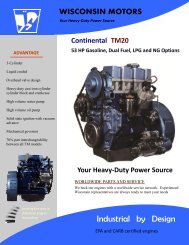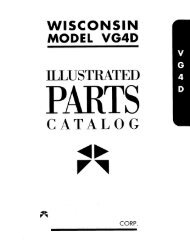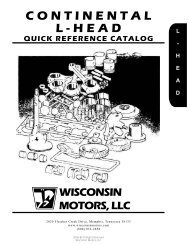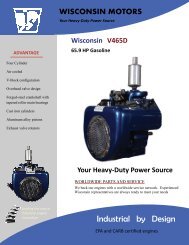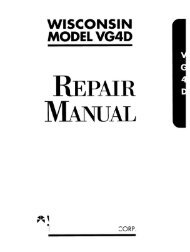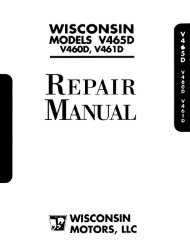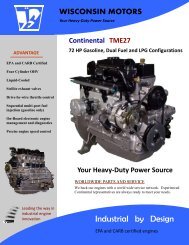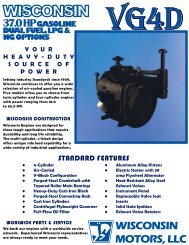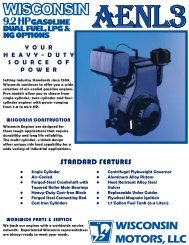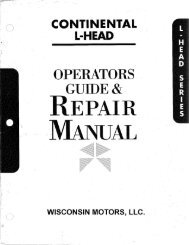REPAIR MANUAL - Wisconsin Motors
REPAIR MANUAL - Wisconsin Motors
REPAIR MANUAL - Wisconsin Motors
- No tags were found...
You also want an ePaper? Increase the reach of your titles
YUMPU automatically turns print PDFs into web optimized ePapers that Google loves.
III.<br />
/ WARNING<br />
Stop engine before checking battery terminals or electrical<br />
connections. Sparks or flames near a battery could<br />
cause an explosion or fire. Battery acid can cause corrosive<br />
burns. Always wear eye protection. Use of jumper<br />
cables or battery charging should be done only as<br />
directed by manufacturers’ safety instructions.<br />
Read and observe safety warnings on pages 1 and 2.<br />
Refer to equipment manufacturer for battery<br />
recommendations.<br />
Alternator<br />
The alternator differs from the conventional<br />
D.C. shunt generator in that the armature is the<br />
stationary member and is called the stator:<br />
while the field is the rotating member and is<br />
called the rotor. Alternating current is rectified<br />
(changed to direct current) by means of diode<br />
rectifiers rather than mechanically with<br />
brushes coming into contact with the various<br />
segments of the rotating armature on the<br />
generator. With this construction, the higher<br />
current values involved in the armature or<br />
stator may be conducted to the external circuit<br />
through fixed leads and connections rather<br />
than through the rotating commutator and<br />
brushes as in D.C. generator. The comparatively<br />
small values of current supplied to the field<br />
may be conducted without difficulty through<br />
small brushes and rotating slip rings.<br />
The alternator is somewhat lighter and more<br />
compact in design than the conventional D.C.<br />
generator of comparable electrical size and is<br />
equally as simple to service and test.<br />
Each bearing is prelubricated which<br />
eliminates the need for periodic lubrication.<br />
Precautions to be observed when testing or servicing<br />
the alternator system:<br />
1. Disconnect the battery, before connecting or<br />
disconnecting test instruments (except<br />
voltmeter) or before removing or replacing any<br />
unit or wiring. Accidental grounding or shorting<br />
at the regulator, alternator, ammeter or accessories,<br />
will cause severe damage to the<br />
units and/or wiring.<br />
2. To avoid damage to the regulator, do not, at<br />
any time, connect battery to the regulator field<br />
terminal.<br />
3. Th field circuit must never be grounded, on<br />
this system, between the alternator and the<br />
regulator. Grounding of the field terminal<br />
either at the alternator or regulator will damage<br />
the regulator.<br />
4. If it is necessary to solder any lead to a rectifi r<br />
lead, use a pair of pliers as a heat dam between<br />
the solder joint and the rectifier.<br />
5. The alternator must not be operated on open<br />
circuit with the rotor winding energized.<br />
6. Do n t attempt to polariz the alternator. No<br />
polarization is required. Any attempt to do so<br />
may result in damage to the alternator,<br />
regulator, or circuits.<br />
7. Grounding of the alternator output terminal<br />
may damage the alternator and/or circuit and<br />
components.<br />
8. Reversed battery connections may damage the<br />
rectifiers, wiring or other components of the<br />
charging system. Battery polarity should be<br />
checked with a voltmeter before connecting<br />
the battery.<br />
9. If a booster battery or fast charger is used, its<br />
polarity must be connected correctly to prevent<br />
damage to the electrical system components.<br />
(positive to positive, negative to<br />
negative.)<br />
IV. Regulator<br />
Most regulators are fully transistorized and<br />
completely sealed. These cannot be adjusted or<br />
repaired, and it can be assumed that this type<br />
regulator will outlive the other components in the<br />
charging system.<br />
Other regulators are adjusted and repaired in<br />
accordance with the manufacturer’s instructions.<br />
Installation of Regulator for Alternator<br />
To insure proper operation and to protect the<br />
alternator and regulator, the following steps<br />
should be observed during installation.<br />
1. Make sure regulator is of the same voltage<br />
and polarity as the alternator and battery.<br />
2. Disconnect battery cable at battery terminal.<br />
3. Make sure the mounting area of the alternator<br />
and regulator base are clean and make<br />
a good tight connection.<br />
4. Connect alternator in accordance with the<br />
manufacturer’s instructions.<br />
5. Do not flash field or ground terminals of the<br />
regulator.<br />
6. Reconnect battery cable.<br />
7. Start engine and observe ammeter. A "High"<br />
charge rate is normal for the first few<br />
minutes, but will decrease as the battery<br />
recharges.<br />
Note: When servicing the charging system, never<br />
remove a unit until tests have shown it to be<br />
defective. Reference always should be made to<br />
the manufacturer’s maintenance manuals for<br />
complete trouble shooting instructions.<br />
33



